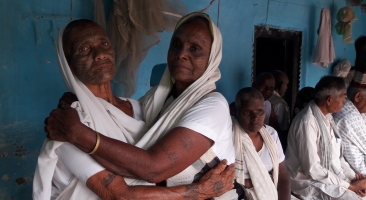The Ramnami Samaj of Chhattisgarh found a rather unique and peaceful way of opposing the caste system in India. Not allowed to enter temples, the community members tattooed their entire bodies, in some cases even eyelids, with the name of ‘Nirgun Ram’ as a way of peaceful defiance against the restrictions imposed on them. A largely illiterate community, they taught themselves to read and write, to be able to read the Ramcharitmanas, and also developed their own musical and clothing traditions. The movement which is spread across dozens of villages in Chhattisgarh is believed to have its roots in the Satnami movement of Chhattisgarh and the Bhakti traditions of the fifteenth century. The community grew to a membership of two lakh members at one point of time, with members from dozens of villages from four districts of Chhattisgarh. They are popularly known for covering their entire body and clothes with the name of Nirgun Ram, using a special indigenous ink. The designs of the tattoos, known as ‘Godna’ in the local language, are inspired by the Ramcharitmanas and the natural surroundings. They are known to promote a simple lifestyle, opposing orthodox customs and rituals. The movement which has largely remained apolitical and devoid of formal hierarchical structures is now witnessing a new era, with the current generation of Ramnamis navigating their way between old traditions and a modern lifestyle.

Vishakha Khetrapal
Vishakha Khetrapal is a researcher, former manufacturing professional, avid traveller and blogger with a postgraduate degree in social entrepreneurship from TISS, Mumbai. Her interest lies in exploring new cultures and indigenous traditions, teaching and working with the youth and children. Vishakha has run an experiential tourism project, engaging with the tribal artisans in Jabalpur, Madhya Pradesh. She is currently exploring the sustainability sector and how our ancient knowledge and wisdom can be put to use to solve the problems of the future.


